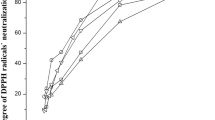Abstract
Watermelon seed oil characteristics were evaluated to determine whether this oil could be exploited as an edible oil. Hexane extraction of watermelon seeds produced yields of 50% (w/w) oil. The refractive index, saponification and iodine value were 1.4712 (at 25 °C), 200 mg KOH/g and 156 g I/100 g, respectively. The acid and peroxide values were 2.4 mg KOH/g and 3.24 mequiv/kg, respectively. The induction time of the oil was also 5.14 h at 110 °C, which was measured for the first time. Total unsaturation contents of the oil was 81.6%, with linoleic acid (18:2) being the dominant fatty acid (68.3%). Considering that the watermelon seed oil was highly unsaturated, the relatively high induction time might indicate the presence of natural antioxidants. In addition, the influence of extraction parameters on extraction of oil from watermelon seed with hexane as a solvent was studied at several temperatures (40, 50, and 60 °C), times (1, 2, and 3 h) and solvent/kernel ratios (1:1, 2:1, and 3:1). The oil yield was primarily affected by the solvent/kernel ratio and then time and temperature, respectively. The protein content of the oil-free residue was 47%.

Similar content being viewed by others

References
Mabaleha MB, Mitei YC, Yeboah SO (2007) A comparative study of the properties of selected melon seed oils as potential candidates for development into commercial edible vegetable oils. J Amer Oil Chem Soc 84:31–36
Bawa AS, Bains GS (1977) Integrated processing of watermelons for juice and seed. Indian Food Packer 31:12
Hasan F (1993) Research on the possibility of using watermelon juice in fruit juice cocktails. Gida 18:369–371
Oyenga VA, Fetuga BL (1975) Some aspects of the biochemistry and nutritive value of the watermelon seed (Citrullus Vulgaris Schrad). J Sci Food Agric 2:843–846
Teotia MS, Ramakrishna P (1984) Chemistry and technology of melon seeds. J Food Sci Technol 21:332–340
Kamel BS, Dawson H, Kakuda Y (1985) Characteristics and composition of melon and grape seed oils and cakes. J Am Oil Chem Soc 62:881–883
El-Adawy TA, Taha KM (2001) Characteristics and composition of different seed oils and flours. Food Chem 74:47–54
Akoh CC, Nwosu CV (1992) Fatty acid composition of melon seed oil lipids and phospholipids. J Am Oil Chem Soc 69:314–316
Helrich K (1990) Official methods of analysis of the Association of Official Analytical Chemists, 15th edn. Virginia, USA
Link WE (1973) Official and tentative methods of the American Oil Chemists’ Society, 3rd edn. AOCS Press, Champaign
Frank J, Geil JV, Freaso R (1982) Automatic determination of oxidation stability of oil and fatty products. Food Technol 146:71–76
Ross PJ (1988) Taguchi techniques for quality engineering. International editions. McGraw-Hill, New York
Li H, Chen B, Zhang Z, Yao S (2004) Focused microwave-assisted solvent extraction and hplc determination of effective constituents in Eucommia ulmodies Oliv. Talanta 63:659–665
Lidefelt J (2007) Handbook vegetable oils and fats, 2nd edn. AAK Press, Sweden
Gustone FD (2002) Vegetable oils in food technology: composition, properties, and uses. Blackwell, Oxford
Simic M, Karel M (1980) Autoxidation in food and biological systems. Plenum Press, New York
Farhoosh R (2007) The effect of operational parameters of the rancimat method on the determination of the oxidative stability measures and shelf-life prediction of soybean oil. J Am Oil Chem Soc 84:205–209
Anwara F, Bhanger MI, Kazi TG (2003) Relationship between rancimat and active oxygen method values at varying temperatures for several oils and fats. J Am Oil Chem Soc 80:151–155
Author information
Authors and Affiliations
Corresponding author
About this article
Cite this article
Moaddabdoost Baboli, Z., Safe Kordi, A.A. Characteristics and Composition of Watermelon Seed Oil and Solvent Extraction Parameters Effects. J Am Oil Chem Soc 87, 667–671 (2010). https://doi.org/10.1007/s11746-010-1546-5
Received:
Revised:
Accepted:
Published:
Issue Date:
DOI: https://doi.org/10.1007/s11746-010-1546-5



